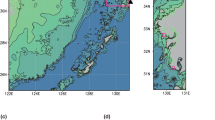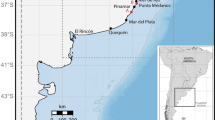Abstract
On Friday, April 13, 2018, a high-amplitude atmospheric inertia–gravity wave packet with surface pressure perturbations exceeding 10 mbar crossed the lake at a propagation speed that neared the long-wave gravity speed of the lake, likely producing Proudman resonance. A set of meteotsunami waves struck the shores near Ludington, Michigan, a coastal community along the sandy dunes of Lake Michigan. During the event, harbor walls were overtopped, damage occurred to shoreline homes and boat docks, and water intake pumps were impacted due to the large change in water level. To fully understand the generation of this event and the impacts to the coastal community, we have carried out atmospheric and hydrodynamic model simulations of the inertia–gravity and meteotsunami waves. Atmospheric simulation of the inertia–gravity waves was performed using a high-resolution model for the Great Lakes region that mimics the National Oceanic and Atmospheric Administration High-Resolution Rapid Refresh operational model. Surface meteorological conditions were supplied to the Lake Michigan-Huron Operational Forecast System, an operational model used for hydrodynamic forecast guidance. This is the first documented case of a meteotsunami generated by an atmospheric inertia–gravity wave in the Great Lakes, and it provides an evaluation of existing and proposed operational infrastructure as it pertains to meteotsunami forecasting in the USA.







Similar content being viewed by others
Data availability
Water level and meteorological data are available from https://tidesandcurrents.noaa.gov/. LMHOFS model input and output are available from https://opendap.co-ops.nos.noaa.gov/thredds/catalog.html.
Code availability
FVCOM code is available from http://fvcom.smast.umassd.edu/FVCOM/Source/code.htm. WRF code is available from https://www2.mmm.ucar.edu/wrf/users/downloads.html.
References
Anderson EJ, Schwab DJ (2013) Predicting the oscillating bi-directional exchange flow in the Straits of Mackinac. J Great Lakes Res 39(4):66671
Anderson EJ, Schwab DJ (2017) Meteorological influence on summertime baroclinic exchange in the Straits of Mackinac. J Geophys Res Oceans 122(3):2171–2182
Anderson EJ, Bechle AJ, Wu CH, Schwab DJ, Mann GE, Lombardy KA (2015) Reconstruction of a meteotsunami in Lake Erie on 27 May 2012: Roles of atmospheric conditions on hydrodynamic response in enclosed basins. J Geophys Res Oceans 120:8020–8038. https://doi.org/10.1002/2015JC010883
Anderson EJ, Fujisaki-Manome A, Kessler J, Lang GA, Chu PY, Kelley JGW, Chen Y, Wang J (2018) Ice forecasting in the next-generation Great Lakes Operational Forecast System (GLOFS). J Mar Sci Eng 6(4):123. https://doi.org/10.3390/jmse6040123
Bechle AJ, Wu CH (2014) The Lake Michigan meteotsunamis of 1954 revisited. Nat Hazards 74:155–177. https://doi.org/10.1007/s11069-014-1193-5
Bechle AJ, Wu CH, Kristovich DAR, Anderson EJ, Schwab DJ, Rabinovich AB (2016) Meteotsunamis in the Laurentian Great Lakes. Sci Rep 6:37832. https://doi.org/10.1038/srep37832
Benjamin SG, Weygandt SS, Brown JM, Hu M, Alexander CR, Smirnova TG, Olson JB, James EP, Dowell DC, Greg GA, Lin H, Peckham SE, Smith TL, Moninger WR, Kenyon JS, Manikin GS (2016) A North American hourly assimilation and model forecast cycle: the rapid refresh. Mon Weather Rev 144:1669–1694. https://doi.org/10.1175/MWR-D-15-0242.1
Chen C, Beardsley RC, Cowles G (2006) An unstructured grid, finite volume coastal ocean model (FVCOM) system. Oceanography 19:78–89
Cho KH, Choi JY, Park KS, Hyun SK, Oh Y, Park JY (2013) A synoptic study on tsunami-like sea level oscillations along the west coast of Korea using an unstructured-grid ocean model. J Coast Res 65:678–683
Haslett SK, Mellor HE, Bryant EA (2009) Meteo-tsunami hazard associated with summer thunderstorms in the United Kingdom. Phys Chem Earth 34:1016–1022
Hibiya T, Kajiura K (1982) Origin of the Abiki phenomenon (a kind of seiche) in Nagasaki Bay. J Oceanogr Soc Jpn 38:172–182
Linares A, Bechle AJ, Wu CH (2016) Characterization and assessment of the meteotsunami hazard in northern Lake Michigan. J Geophys Res Oceans 121(9):7141–7158. https://doi.org/10.1002/2016JC011979
Linares A, Wu CH, Bechle AJ, Anderson EJ, Kristovich DAR (2019) Unexpected rip currents induced by a meteotsunami. Sci Rep 9:2105. https://doi.org/10.1038/s41598-019-38716-2
Monserrat S, Vilibić I, Rabinovich AB (2006) Meteotsunamis: Atmospherically induced destructive ocean waves in the tsunami frequency band. Nat Hazards Earth Syst Sci 6(6):1035–1051
Nomitsu T (1935) A theory of tsunamis and seiches produced by wind and barometric gradient. Mem Coll Sci Kyoto Imp Univ 18:201–214
Orlić M, Belušić D, Janeković I, Pasarić M (2010) Fresh evidence relating the great Adriatic surge of 21 June 1978 to mesoscale atmospheric forcing. J Geophys Res 115:C06011
Power JG et al (2017) The weather research and forecasting model: overview, system efforts, and future directions. Bull Am Meteorol Soc 98:1717–1737
Proudman J (1929) The effects on the sea of changes in atmospheric pressure. Geophys Suppl Mon Not R Astron Soc 2(4):197–209
Rabinovich AB (2009) Seiches and harbor oscillations. In: Kim YC (ed) Handbook of coastal and ocean engineering. World Sci, Singapore, pp 193–236
Rabinovich AB, Monserrat S (1996) Meteorological tsunamis near the Balearic and Kuril Islands: descriptive and statistical analysis. Nat Hazards 13:55–90
Šepić J, Vilibić I, Fine I (2015) Northern Adriatic meteorological tsunamis: assessment of their potential through ocean modeling experiment. J Geophys Res Oceans 120:2993–3010
Smith SD (1980) Wind stress and heat flux over the ocean in gale force winds. J Phys Oceanogr 10:709–726
Spillane MC, Gica E, Titov EE, Mofjeld HO (2008) Tsunameter network design for the U.S. DART arrays in the Pacific and Atlantic Oceans. NOAA Technical Memorandum OAR PMEL-143
Thiébaux J, Rogers E, Wang W, Katz B (2003) A new high-resolution blended real-time global sea surface temperature analysis. Bull Am Meteorol Soc 84:645–656
Vilibić I (2005) Numerical study of the Middle Adriatic coastal waters’ sensitivity to the various air pressure travelling disturbances. Ann Geophys 23(12):3569–3578
Vilibić I, Šepić J (2017) Global mapping of nonseismic sea level oscillations at tsunami timescales. Sci Rep 7:40818
Ye X, Anderson EJ, Chu PY, Huang C, Xue P (2018) Impact of water mixing and ice formation on the warming of Lake Superior: a model-guided mechanism study. Limnol Oceanogr 64:558–574
Acknowledgements
This is GLERL publication number 1956.
Author information
Authors and Affiliations
Contributions
EA and GM conceived of and wrote the manuscript. GM completed the atmospheric simulations. EA completed the hydrodynamic simulations. EA and GM analyzed model results.
Corresponding author
Ethics declarations
Conflict of interest
The authors declare that they have no conflict of interest.
Additional information
Publisher's Note
Springer Nature remains neutral with regard to jurisdictional claims in published maps and institutional affiliations.
Rights and permissions
About this article
Cite this article
Anderson, E.J., Mann, G.E. A high-amplitude atmospheric inertia–gravity wave-induced meteotsunami in Lake Michigan. Nat Hazards 106, 1489–1501 (2021). https://doi.org/10.1007/s11069-020-04195-2
Received:
Accepted:
Published:
Issue Date:
DOI: https://doi.org/10.1007/s11069-020-04195-2




